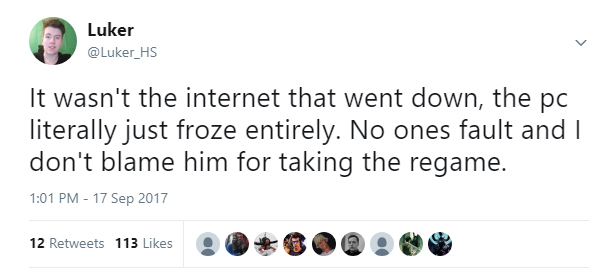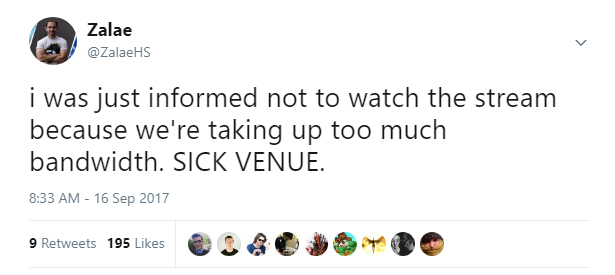The Hearthstone Championship Tour is the biggest event in Hearthstone. Over the course of months, players vie for a spot in the illustrious Hearthstone World Championship. With amateurs and pro players alike pouring hours into the game for a shot at the $1 million prize pool, you’d expect things to run seamlessly. Unfortunately, at last weekend’s HCT America’s Summer Champions, this was not the case.
While production quality was, as always, top-notch, making for an exciting watch, several issues troubled the competitors themselves. Internet connect was frustratingly unreliable at several locations and bracket pairings in the late rounds of Swiss, resulting in many competitors expressing their concerns over an even playing field.
Internet Connection
The most consistent issues during the HCT Americas tournament was spotty internet connections at the venues hosting qualified players.
Professional Hearthstone players expect some amount of variance in game, but shouldn’t be subject to variable connections. Stable internet is critical to the multi-location nature of HCT events and a poor connection can result in a wealth of problems.
Disconnects
Of the problems that arise from unreliable internet, Disconnects are most apparent. Players were too frequently forced to restart games due to loss of connection both on and off stream.
Most notably, however, was the situation involving Luker during his play and in match for the Summer Championship. With an opportunity to swing the game back in his favor and put himself in a clearly dominant position, Luker’s PC froze and he was unable to make the obvious play he was presented with.

Hearthstone rules state that, unless lethal damage is in play, disconnected games are restarted. Luker went on to lose a game that he effectively already won, missing out on his chance at the World Championship in the process.
While Luker’s situation was the most prominent due to the stakes involved, it was far from the only occurrence. Players from a variety of locales reported inconsistent internet access throughout the rounds of Swiss.
Even without dropping from the game entirely, spotty internet can prevent players from taking full turns. This problem is magnified in a deck like Highlander Priest whose win condition requires the player to account for time between animations.
Similarly, the lingering threat of a disconnect can negatively impact play. Competitors feeling the heat of spotty internet might rush through turns to ensure they get everything queued up.
Finally, there’s the psychological aspect of the frustration and tilt induced by constantly losing connection to the game. Disconnecting from a game is infuriating, regardless of where the blame is placed. In Luker’s case, he made a fairly critical mistake in the regame which can easily be attributed to frustration from the situation.
Mulligan Phase
While not as visible to those watching the stream, the internet problems extended beyond just disconnects, however. Players at the Boston venue reported that, on top of disconnecting several times, they weren’t able to view their opponent’s mulligan.
For those who aren’t aware, the mulligan phase in Hearthstone gives critical information in high-level play. Knowing which cards were kept gives experienced players the ability to make informed reads about what their opponent has in hand. Not being able to reliably view their opponent’s mulligan choices put players in this location at a severe disadvantage throughout the tournament.
Relocation
The internet at the Boston venue was so unreliable, in fact, players had to be relocated on day two just to play their matches. Again, a seemingly minor issue puts a subset of competitors at another small disadvantage. Frantically moving to another location adds another layer of stress on those competing, which has the potential to impact gameplay.
Stream Viewing
At another venue, Zalae was informed he couldn’t watch the stream because of concerns over bandwidth. While certainly not as critical as disconnecting from game, it does, once more, put certain players at a disadvantage (if only slightly). Watching the stream between matches can not only give insight into player tendencies, but also can provide some much-needed amusement between matches. Competing in anything is stressful and having an outlet to reduce anxiety is crucial to maintaining a positive mindset.

Bracket Pairings
Blizzard’s decision to move away from double elimination and towards a Swiss-system is certainly a step in the right direction. Swiss tournaments are the gold-standard tournament structure when the number of competitors is too large to accommodate round-robin. However, questionable late round pairings once again put some players at a disadvantage.
In situations where an odd number of players are still alive, a bye is granted and a player receives a win for that round in their record.
While, superficially, a bye seems like a good thing because it results in a win, it can actually hinder the chances of players on the bubble. Players with two losses, specifically, were reliant on tiebreakers to qualify for the top 8. Getting a bye results in a win, but, because tiebreakers are determined by opponent record, it takes qualification out of the player hands.
Typically, pairings are done on a top-down basis, meaning those with the most points get paired into matches first and, if there is an odd number of players, those at the bottom receive a bye. This is done to award the higher seeds previous success and improve their chances of qualification.
However, it was later unsurfaced that the Battlefy system ended up pairing players at two losses randomly. As a result, PNC, despite being near the top of the players with two losses at the time, was granted a bye. Doing so effectively took his chance of qualification out of his hands, .
Solution
Moving forward, more needs to be done to support the players that qualify for HCT events. Hearthstone eSports is as much a personality driven endeavor as it is skill based. For the competitive scene to continue to grow, players need to feel that their interests are considered. Otherwise, more and more will begin to flee the scene.
While the internet connection of venues is outside of Blizzard’s hands, the selection of venues is well within their control. Proper vetting of locations is paramount to providing an even playing field for players at the variety of locations. After all, this is not the first time that players have expressed concern over the choice of venue.
In-game, the reconnect feature needs improvement, as even those who have lost connection during a Ladder match can tell you. The frustration over having to restart the game when a player drops is unsatisfying for all involved.
Connection losses are inevitably going to occur, no matter the location. For competitive play to progress, a mechanism for effectively reconnecting players back into the moment they were dropped needs to be implemented. Other games have features that save game states to eliminate the need for regames. Sooner, rather than later, Hearthstone must implement something similar to prevent unlosable games from being replayed.
The Hearthstone tournament scene is still fairly young and, in general, has made great strides in terms of competitive integrity. The HCT America Summer Playoffs is likely an outlier in an otherwise improved system and, while it is an unfortunate step back in some regard, hopefully the visibility of some of the issues will help induce continued positive change.
